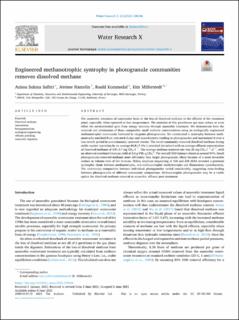| dc.contributor.author | Safitri, Anissa Sukma | |
| dc.contributor.author | Hamelin, Jerome | |
| dc.contributor.author | Kommedal, Roald | |
| dc.contributor.author | Milferstedt, Kim | |
| dc.date.accessioned | 2021-06-30T09:25:01Z | |
| dc.date.available | 2021-06-30T09:25:01Z | |
| dc.date.created | 2021-06-28T13:56:31Z | |
| dc.date.issued | 2021-06 | |
| dc.identifier.citation | Safitri, A.S., Hamelin, J., Kommedal, R., Milferstedt, K. (2021) Engineered methanotrophic syntrophy in photogranule communities removes dissolved methane. Water Research X, 12, 100106 | en_US |
| dc.identifier.issn | 2589-9147 | |
| dc.identifier.uri | https://hdl.handle.net/11250/2762510 | |
| dc.description.abstract | The anaerobic treatment of wastewater leads to the loss of dissolved methane in the effluent of the treatment plant, especially when operated at low temperatures. The emission of this greenhouse gas may reduce or even offset the environmental gain from energy recovery through anaerobic treatment. We demonstrate here the removal and elimination of these comparably small methane concentrations using an ecologically engineered methanotrophic community harbored in oxygenic photogranules. We constructed a syntrophy between methanotrophs enriched from activated sludge and cyanobacteria residing in photogranules and maintained it over a two-month period in a continuously operated reactor. The novel community removed dissolved methane during stable reactor operation by on average 84.8±7.4% (±standard deviation) with an average effluent concentration of dissolved methane of 4.9±3.7 mg CH4∙l−1. The average methane removal rate was 26 mg CH4∙l−1∙d−1, with an observed combined biomass yield of 2.4 g VSS∙g CH4−1. The overall COD balance closed at around 91%. Small photogranules removed methane more efficiently than larger photogranule, likely because of a more favorable surface to volume ratio of the biomass. MiSeq amplicon sequencing of 16S and 23S rRNA revealed a potential syntrophic chain between methanotrophs, non-methanotrophic methylotrophs and filamentous cyanobacteria. The community composition between individual photogranules varied considerably, suggesting cross-feeding between photogranules of different community composition. Methanotrophic photogranules may be a viable option for dissolved methane removal as anaerobic effluent post-treatment. | en_US |
| dc.language.iso | eng | en_US |
| dc.publisher | Elsevier Ltd. | en_US |
| dc.rights | Attribution-NonCommercial-NoDerivatives 4.0 Internasjonal | * |
| dc.rights.uri | http://creativecommons.org/licenses/by-nc-nd/4.0/deed.no | * |
| dc.subject | vann | en_US |
| dc.title | Engineered methanotrophic syntrophy in photogranule communities removes dissolved methane | en_US |
| dc.type | Peer reviewed | en_US |
| dc.type | Journal article | en_US |
| dc.description.version | publishedVersion | en_US |
| dc.rights.holder | © 2021 The Authors. | en_US |
| dc.subject.nsi | VDP::Matematikk og Naturvitenskap: 400 | en_US |
| dc.source.volume | 12 | en_US |
| dc.source.journal | Water Research X | en_US |
| dc.identifier.doi | 10.1016/j.wroa.2021.100106 | |
| dc.identifier.cristin | 1918943 | |
| dc.source.articlenumber | 100106 | en_US |
| cristin.ispublished | true | |
| cristin.fulltext | original | |
| cristin.qualitycode | 1 | |

